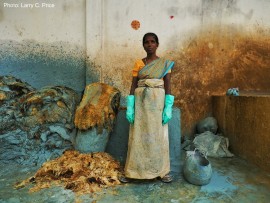Tannery Operations
Leather tanning is the process of converting raw animal hides or skins into leather for consumer products. Tannery processes treat raw hides to remove animal hair, flesh and oil glands using tannic acid and other chemical substances that prevent decay, make them resistant to wetting, and keep them durable1. Tanning uses tannins, chromium, alum or other chemical agents, some of which can be hazardous to human health and the environment, if not carefully controlled. Of particular concern is the use of chromate salts, commonly used in the stabilization process2. Uncontrolled chromium wastes and chromium-contaminated wastewater can be released into the environment at high amounts3. Most tanning operations are regulated, but there are still many small tanneries operating with few controls.
Key Pollutants
Chromium is the most pervasive and hazardous pollutant found in the tannery processes. Trivalent chromium is used as part of the tanning process and is washed off from leathers and can be present in tannery wastewater in significant amounts. Trivalent chromium is not highly toxic, but in its use in various processes can oxidize into the more harmful hexavalent chromium4. Hexavalent chromium is a carcinogen that can be potentially harmful to lung and stomach cancer.
There are more than 100 sites identified by the Pure Earth Toxic Sites Identification Program polluted by tannery operations, putting almost 1.5 million people at risk. These sites consist of contaminated legacy tannery sites or small poorly run facilities. Pure Earth estimates that exposure to hexavalent chromium and lead specifically from tanneries contributes to about 15 percent of the some 925,000 to 1.19 million DALYs in the area of the 100 identified sites.
Exposure Pathways
Harmful chemicals, primarily hexavalent chromium, can be discharged as wastewater or in solid waste and sludge. Chromium can be present in wastewater at level up to 100-400mg/L5. Untreated wastewater can also contain acids and alkalis water, pesticides and insecticides, and other harmful chemicals. Solid waste products can include chromium-contaminated waste and animal flesh that can contribute pathogens. The waste is often released through direct dumping or improper disposal in unprotected dumpsites. Pollutants may be absorbed by the soil and leach into groundwater sources. The main pathways for human exposure to pollutants from tanneries are ingestion of contaminated food and water.
2. Bosnic, M. et al. “Pollutants in Tannery Effluents.” United Nations Industrial Development Organization. Regional Programme for Pollution Control in the Tanning Industry in Southeast Asia. 2000.
3. Ingle, K.N et al. “Policy framework for formulating environmental management strategy for sustainable development of tanneries in India.” Environ Health Prev Med (2011) 16:123–128
4. Bosnic, M. et al. “Pollutants in Tannery Effluents.” United Nations Industrial Development Organization. Regional Programme for Pollution Control in the Tanning Industry in Southeast Asia. 2000.
5. Tanning and Leather Finishing”. Pollution Prevent and Abatement Handbook. World Bank Group. 1998




